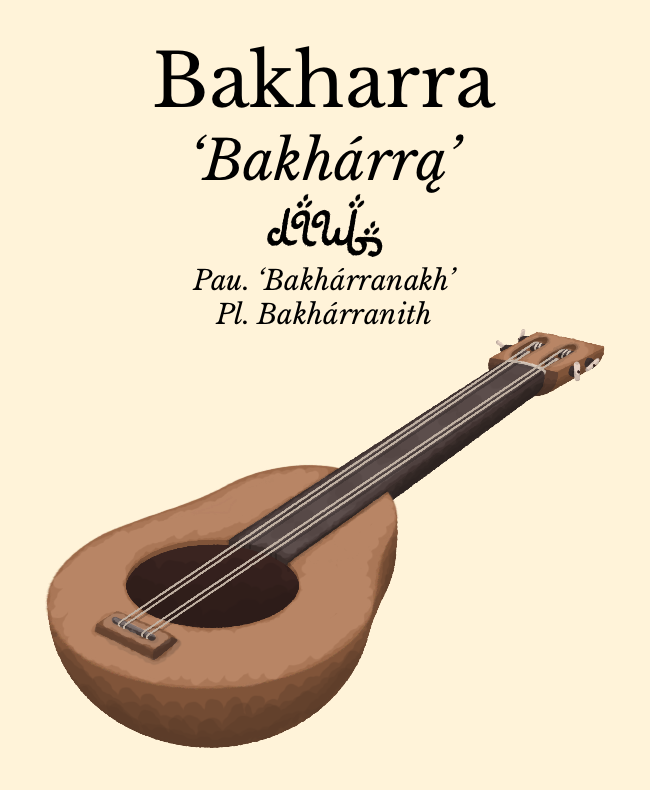Sarvaran Instruments
# Overview
Sarvaran culture was rich with artwork and innovation. The four most prominent fields in ancient Sarvara were pottery, poetry, architecture, and music. Music was an integral part of the culture, allowing all Minikin to express themselves through sound, in worship, in pain, and in love. Sarvaran music wouldn’t exist without the culture’s diverse range of instruments.
# Sarvaran Tuning
Sarvaran tuning is made up of octaves of 8 tones. These tones generally follow pythagorean tuning, and are each named after the numbers. The first tone was roughly analogous to the note of A (44o Hz) in western tuning, although there was no standardisation in the time of the Sarvaran Civilisation until the advent of the Empire Of The Petrified Child.
# Bakharra
The bakharra1 is a stringed instrument with 2 courses of doubled strings. The courses are commonly tuned a 5th apart (e.g. D and A), and each course is made up of two strings tuned an octave apart. It features a neck and head traditionally made of Dhajarh wood, tuning pegs made of ivory collected from wooly boars, a resonation chamber made of a gourd, and strings made of wooly hog intestines.

Bakharranith are commonly used as background drones in Sarvaran music, occupying the mid-bass area of the pitch spectrum. Bakharra melodies are often the two courses being struck in alternation with one finger across the neck, but sometimes two fingers are used on each course, allowing the player to create more intricate melodies.
The Bakharra was commonly plucked in Sarvaran music, but in late Sarvaran culture, and especially in the following culture of the Empire of the Petrified Child, began to be bowed.
# Bowed Bakharra
The Bowed Bakharra was played with a bow made of Dhajarh wood and Snoutgoat tail hair, known as a Djenna2. It often appeared as part of an ensemble, and would go on to become a staple in Stonechild Imperial orchestral music.
# Bakhalamu
The Bakhalamu3, part of the Bakharra family, is a similar stringed instrument. However, this instrument does not have courses and is made up of 3 strings, as shown in the instrument’s meaning in the Sarvaran language.
The Bakhalamu was generally used as a treble instrument, to perform the main melody of a song or hymn overtop a backdrop of Bakharranith, Kuyudranith, and Danaikith.
# Danaika
The Danaika4 is a wind instrument made traditionally of bone, or otherwise of Dhajarh wood, with 8 holes drilled on each side of its length, totalling 2 octaves in the Sarvaran tuning system. Danaikith commonly take the role of the lead or as part of an ensemble in Sarvaran music.
# Kuyudra
The Kuyudra5 is a percussion instrument made of wooly hog skin that has been treated and stretched over a cylindrical or hemispherical wooden frame. These are placed inbetween the legs, in the lap, or between the feet of the player.
Kuyudranith are beaten in time to the accompanying instruments, providing a sense of rhythm, and feature in a genre of musical poetry where the drum alone accompanies a spoken-word vocalist, and is struck with each heavy syllable of the poem recited.
Sarvaran ‘Bakharrą’ « Proto-Morellic ‘*Bakha-azzan’ meaning ’two (courses of) strings.’ ↩︎
Sarvaran ‘Djenna’ « Proto-Morellic ‘*Dyenna’ meaning ‘bow of an instrument.’ (cf. ‘Bakharrą Djennarilh’, meaning ‘bowed bakharra.’) ↩︎
Sarvaran ‘Bakhalamų’ « Proto-Morellic ‘*Bakha-lhamun’ meaning ’three strings.’ ↩︎
Sarvaran ‘Danaika’ « Proto-Morellic ‘*Danu-âkâ’ meaning ‘bone flute.’ ↩︎
Sarvaran ‘Küyudra’ « Proto-Morellic ‘*Kuya-udza’ meaning ‘skin drum.’ ↩︎